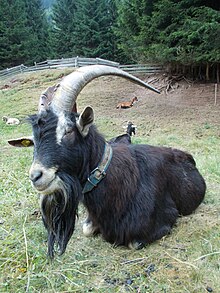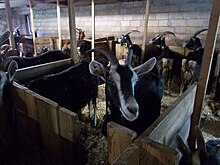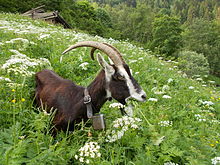Grisons radiant goat
The Bündner Strahlenziege (formerly also "Bündner Ziege") is a black and white colored old Swiss domestic goat . This mountain goat breed originated in the Surselva in the canton of Graubünden .
Traditional attitude and meaning
Up until the beginning of the 20th century, goats played a decisive role as meat , but above all as a supplier of milk in Switzerland in providing people with basic supplies. This applies in particular to the mountain regions, where arable farming is only possible to a very limited extent and where there is only little suitable pasture area available for cows. The naturally undemanding and sure-footed goats are the only European livestock that can graze the steep and barren mountain slopes. As a result, numerous mountain goat breeds have developed in the high alpine regions of Switzerland over the centuries, which are adapted to the climatic and geographical conditions as well as to the region-specific traditional husbandry. In Graubünden's Surselva this was the radiant goat. Up until the First World War, every family there owned at least one, usually several, goats, so that there were more goats than inhabitants in Graubünden by the turn of the century. The importance of goats for the mountain regions of Graubünden is also reflected in the vocabulary of the Rhaeto-Romanic language, in which there are many specific expressions relating to goat husbandry (for example the distinction ansiel / ansola for “male / female kid”, chavrer for “goatherd” ", Stargella for" young goat ").
It is unclear from which breed the radiant goat emerged and since when it showed its breed-specific characteristics. It is generally assumed that they are closely related to the Nera Verzasca goat, which is native to Ticino . It was first mentioned in a document in 1913, and the radiant goat has been a recognized independent breed since 1938.
Traditionally, during the summer, the goats were milked early in the morning (between four and five o'clock) and then picked up by goatherds, mostly boys aged eight and over, and then driven to the pasture allocated to them. Not infrequently this meant marches of several kilometers and overcoming a few hundred meters of altitude. In the late afternoon the shepherd brought the goats back, whereupon they were milked again and then spent the night in a stable or paddock.
In accordance with the requirements, value was placed on marching-ready, robust, sure-footed and herd-oriented goats with the circumstances correspondingly high milk yield, characteristics that are still characteristic of radiant goats today.
The goats were also summered in the Alps , where their milk was processed into cheese. Mainly, however, they were kept to provide the farmers with milk during the summer when the cows were on the alp.
Physical characteristics
The radiant goat is a medium-sized goat (height at the withers: female 75 to 85 cm, male 80 to 90 cm, with a minimum weight of 50 kg for goats and 70 kg for rams) with strong limbs and large horns. All specimens have horns and a more or less pronounced beard, not all have shags. As with the other Swiss mountain goat breeds, it is characterized by the often split udder.
The coat is short and smooth. The main color is anthracite to black.
The name is given by the white badges on the head (in Bünder dialect: "rays" or "strala" in Rhaeto-Romanic ), which extend from the nose to the ears, which are also always white. In some specimens, especially in males, these rays can also be interrupted. Furthermore, the mirror as well as the limbs ("boots") and sometimes parts of the abdomen are white.
This drawing, called "swiss markings" in Great Britain, corresponds to that of the Toggenburg goat , whose basic color is light brown, as well as some other goat breeds that emerged from one of these two breeds, e.g. B. the British Alpine from Great Britain, the Thuringian forest goat from Germany or the Capra Frisa Frontalsasca as the Valtellina / Italy.
Recently the radiant goat has also been genetically bred without being polled.
Essence
The ray goat is of a calm mind. She has a strong herd instinct and feels most comfortable in large herds of 30 to 100 animals. Radiant goats are very sure-footed and love to graze on steep terrain, even when equivalent or more abundant feed is available in flatter regions. They have a high urge to move around and are unsuitable for keeping them in a stable - most breeders allow their animals to exercise even during the winter months.
power
The average milk production of the radiant goat is 601.4l kg per lactation period (236.6 days, which corresponds to 2.54 kg per day). This is below average compared to the other Swiss goat breeds. The milk is particularly rich (3.4% fat, 3.0% protein, 4.6% lactose: top values for Swiss goat breeds with typical feeding).
Since 1992, increasing milk production has been set as the primary breeding goal. For this purpose, British Alpine bucks were crossed in two batches in 1992 and 1994 , a breed that is believed to have descended from the ray goats and which has been bred to a high-performance breed in Great Britain since 1903 (1099 kg at 270–365 days; 4.12% fat, 2.97 % Protein).
The success of this measure is controversial, as the imported breeding rams were hardly suitable for the mountains and they and their offspring were more susceptible to disease.
Inventory development
Radiant goats were particularly affected by the decline in goats in the course of the industrialization of agriculture from 1950 onwards. In 1993 the herdbook population fell to 305 animals (1974: 1283). Measures taken by Graubünden goat breeders and the ProSpecieRara foundation were able to successfully prevent the breed from becoming extinct and resulted in a steady increase in the population. In 2004 there were already 1434 animals in the herdbook. In the meantime (as of May 1, 2013) 2285 ray goats are registered. (These figures only give limited information about the actual population. It is estimated that around a third of the goats kept nationwide are registered in the herd book.) The Swiss Goat Breeding Association (SZZV) lists the radiant goat as an endangered breed.
literature
- Urs Weis (ed.): Swiss goats. Birken Halde Verlag, 2004.
Web links
- Information about the Bündner Strahlenziege on the ProSpecieRara website
- Website of the Swiss Goat Breeding Association on the breed with breed standard
Individual evidence
- ↑ Bündner Strahlenziege. In: prospecierara.ch. ProSpecieRara, 2014, accessed January 9, 2014 .
- ↑ Endangered races. ( Memento of the original from January 31, 2014 in the Internet Archive ) Info: The archive link was inserted automatically and has not yet been checked. Please check the original and archive link according to the instructions and then remove this notice. In: szzv.caprovis.ch. Swiss Goat Breeding Association (SZZV), January 8, 2014, accessed on January 9, 2014.


